*** Outline ***
(A) 13C CPMAS spectrum of Camphor
13C CPMAS lineshapes of Camphor in a 4-mm diameter rotor spinning at 5 kHz
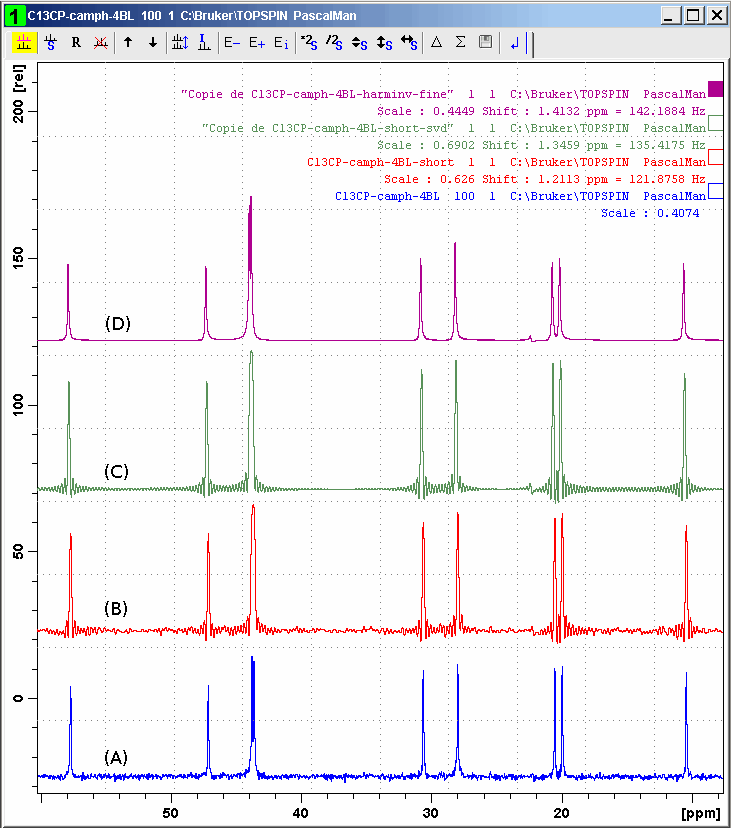
13C CPMAS spectrum of Camphor: (A) with AQ = 100 msec; (B) with AQ = 40 msec; (C) Fourier transform of SVD denoised FID of (B); (D) Fourier transform of harmonic inversion of the SVD denoised FID of (C).
Acquisition parameters:
| General | |
| PULPROG | cp |
| TD | 4996 |
| NS | 32 |
| DS | 0 |
| SWH [Hz] | 25000.00 |
| AQ [s] | 0.0999900 |
| RG | 4096 |
| DW [µs] | 20.00 |
| DE [µs] | 10.00 |
| D1 [s] | 5.00000000 |
| NUC1 | 13C |
| P15 [µs] | 10000.00 |
| PL1 [dB] | 5.40 |
| SFO1 [MHz] | 100.6148134 |
| NUC2 | 1H |
| P3 [µs] | 9.00 |
| PL2 [dB] | 9.40 |
| PL12 [dB] | 14.00 |
| SFO2 [MHz] | 400.1299619 |
(B) Harmonic inversion processing procedure
+++Original data file+++
In TopSpin, process the TopSpin file C13CP-camph-4BL by convdta command and
save it as C13CP-camph-4BL 100.
+++Generate data with shorter AQ+++
Save TopSpin file C13CP-camph-4BL 100 as a JCAMP-DX file C13CP-camph-4BL.dx on the Desktop of Windows.
Make a copy of the JCAMP-DX file C13CP-camph-4BL.dx as Copie de C13CP-camph-4BL.dx on the Desktop of Windows.
Open the JCAMP-DX file C13CP-camph-4BL.dx with MS Bloc-notes; delete the two second half parts of the FID; change the value of TD accordingly; save the JCAMP-DX file as C13CP-camph-4BL-short.dx on the Desktop of Windows.
Make a copy of the JCAMP-DX file C13CP-camph-4BL-short.dx as Copie de C13CP-camph-4BL-short.dx on the Desktop of Windows.
Introduce the JCAMP-DX file C13CP-camph-4BL-short.dx back to TopSpin.
+++FID denoising with SVD Java applet+++
Open MS Excel, File > Open; open the JCAMP-DX file C13CP-camph-4BL-short.dx; select the real part and the imaginary part of the FID and paste them into SVD applet for denoising.
Save the the real part and the imaginary part of denoised FID back to the JCAMP-DX file C13CP-camph-4BL-short.dx with MS Excel; change the format of the cells to integer numbers; close the file by saving it as a text file.
Open the JCAMP-DX file C13CP-camph-4BL-short.dx as a text file with MS Bloc-notes; open the JCAMP-DX file Copie de C13CP-camph-4BL-short.dx as a text file with MS Bloc-notes; copy the FID data from C13CP-camph-4BL-short.dx to Copie de C13CP-camph-4BL-short.dx.
Make a copy of Copie de C13CP-camph-4BL-short.dx; rename this new file as Copie de C13CP-camph-4BL-short-svd.dx; then introduce it back to TopSpin.
Make a copy of Copie de C13CP-camph-4BL-short.dx on the Desktop of Windows then rename it as C13CP-camph-4BL-short-svd.dx.
+++Harmonic inversion applied to SVD denoised FID+++
Open MS Excel, File > Open; open C13CP-camph-4BL-short-svd.dx; open a new file of OpenOffice3 Calc; select the real part and the imaginary of the FID from C13CP-camph-4BL-short-svd.dx and paste them into the new OpenOffice3 Calc file; generate the complexe form of the data with the function COMPLEXE(cell; cell; "i"); then save it with filename camphecpmas.ods.
Select the complex form of the data in OpenOffice3 Calc and paste them into MS Bloc-notes as a text file; save the text file with the filename mimicamphe on the Desktop of Windows; delete its filename extension if present.
Put the file mimicamphe in the folder of harminv-1.3.1.
Start Cygwin:
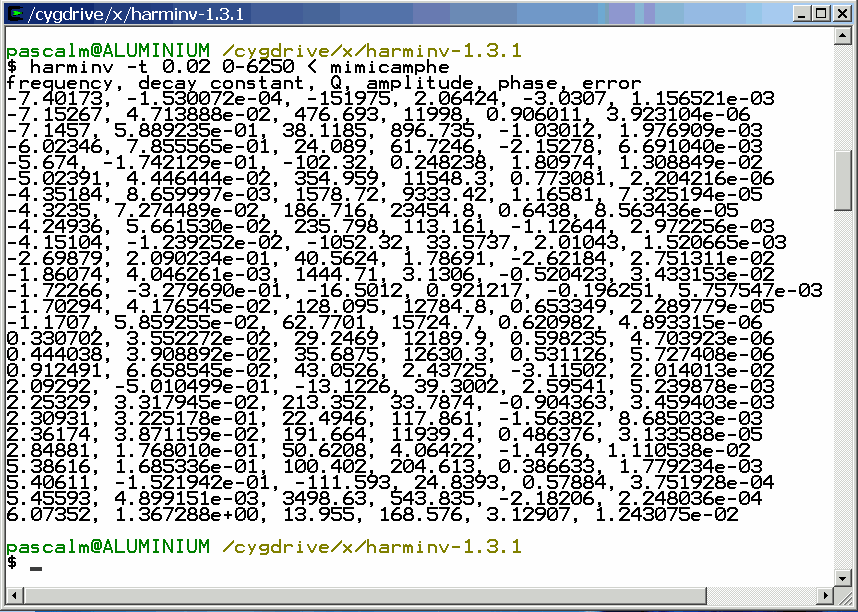
Select and copy the data in Cygwin window; then paste them in MS Bloc-notes as a text file called harminvcamphe1.txt.
Open MS Excel, File > Open; open harminvcamphe1.txt; the cell separator is comma;
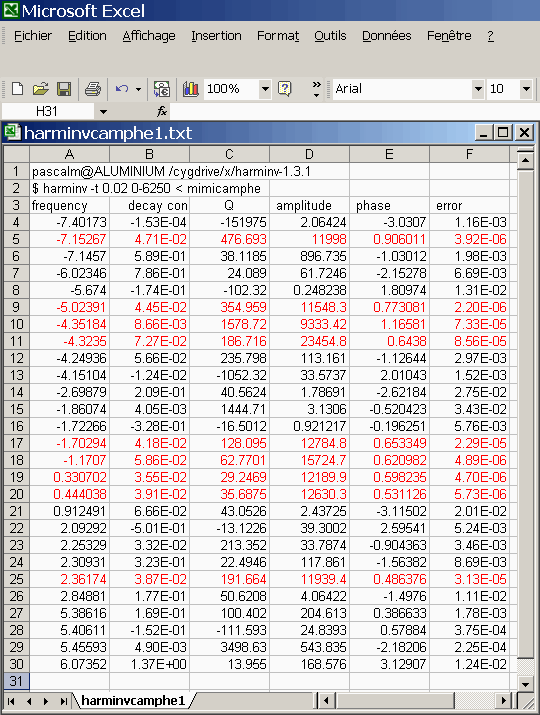
With the 9 highest amplitude signals (they have low errors and small decay constants), we generate an OpenOffice3 Calc file called harminvcamphe-fine.ods, in which the values of decay constants are divided by ten and the number of complexe FID intensities is increased by four.
+++Generate JCAMP-DX file with longer AQ++
We do not detail this last step.
Generate a new JCAMP-DX file with the harmonic inversion data, called
Copie de C13CP-camph-4BL-harminv-fine.dx,
in which some lines are modified:
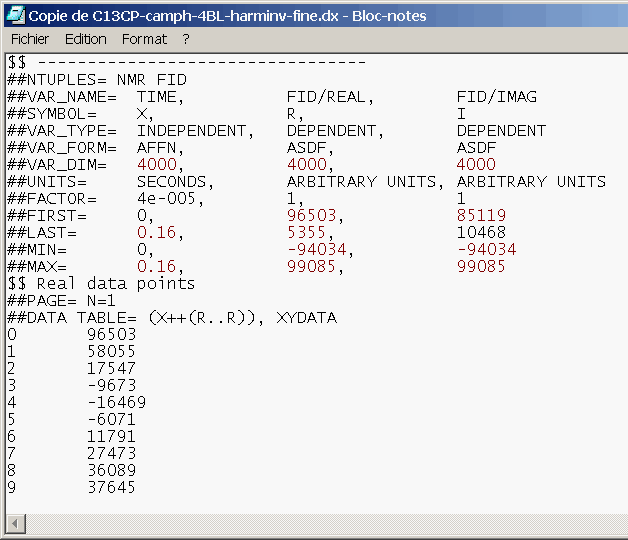
TD is also changed accordingly; introduce this JCAMP-DX file in TopSpin.
(C) Comments
The well known definition of the acquisition time AQ of an FID is related to the number of time-domain data points TD and the dwell time DW of the FID by:
AQ = TD*DW
From mathematical point view, the complexe points of an FID are sampled simultaneously and TD is therefore the number of complexe points of an FID.
In TopSpin, TD is the number of real sampled points plus the number of imaginary sampled points. In other words, TD is twice the number of complexe points of an FID. To maintain AQ value unchanged, DW is divided by two. As a result, the frequencies provided by harminv-1.3.1 applied to TopSpin data are twice that expected, in addition to the change of signs.
NoteTab Light, a freeware text editor installable in USB key, can be used (tabulation = ^T).
tabulation in OpenOffice3:
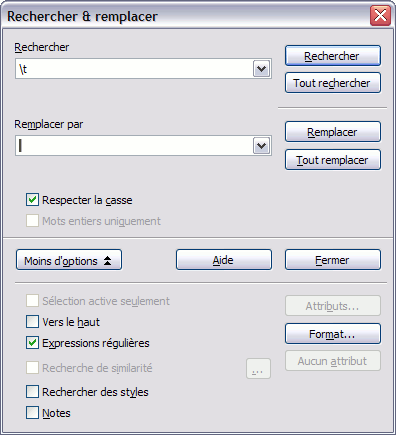
tabulation in MS Word:
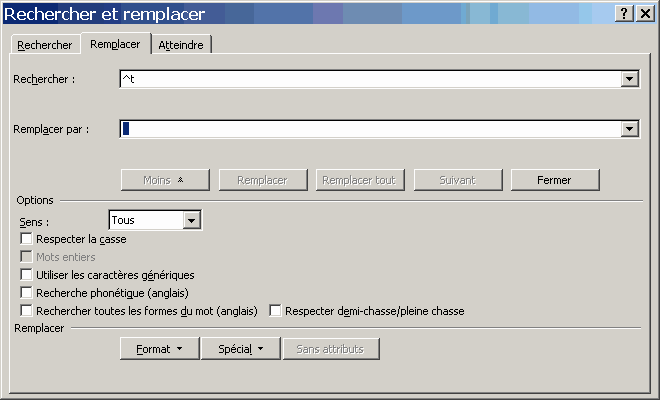
(D) Reference
-
Grant N. Holder, David G. Farrar, and David M. Gooden
A senior-level experiment in structural elucidation using 2-D NMR,
Chem. Educator 4, 173-176 (1999).
Abstract
